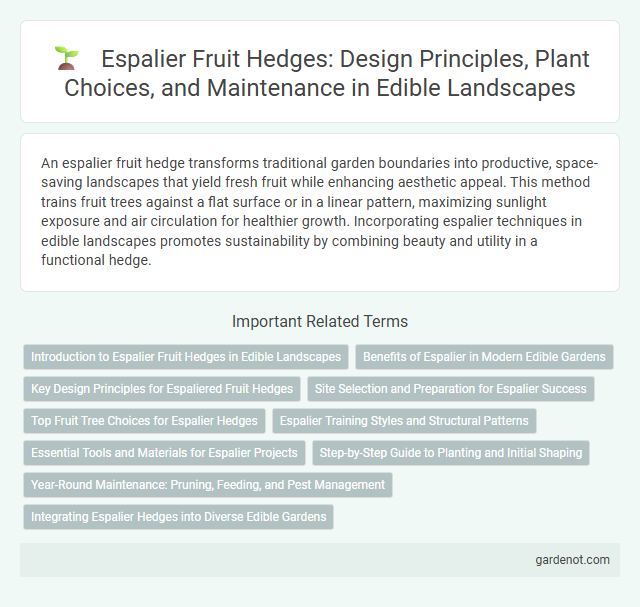An espalier fruit hedge transforms traditional garden boundaries into productive, space-saving landscapes that yield fresh fruit while enhancing aesthetic appeal. This method trains fruit trees against a flat surface or in a linear pattern, maximizing sunlight exposure and air circulation for healthier growth. Incorporating espalier techniques in edible landscapes promotes sustainability by combining beauty and utility in a functional hedge.
Introduction to Espalier Fruit Hedges in Edible Landscapes
Espalier fruit hedges transform limited garden spaces into productive, visually striking edible landscapes by training fruit trees flat against a support structure. This technique maximizes sunlight exposure and air circulation, promoting healthy growth and easier harvesting for varieties like apple, pear, and stone fruits. Integrating espalier fruit hedges enhances garden aesthetics while providing fresh, homegrown fruit in a compact, low-maintenance design.
Benefits of Espalier in Modern Edible Gardens
Espalier fruit hedges maximize space efficiency by training fruit trees flat against walls or fences, making them ideal for small urban gardens. This technique enhances sunlight exposure and air circulation, promoting healthier fruit production and reducing disease risk. Espalier also offers aesthetic appeal by creating structured, edible living walls that seamlessly integrate productivity and design in modern edible landscapes.
Key Design Principles for Espaliered Fruit Hedges
Espalier fruit hedges require precise pruning techniques to maintain flat, two-dimensional growth that maximizes sunlight exposure and air circulation, essential for fruit development and disease prevention. Strategic spacing between plants ensures optimal root expansion and reduces competition for nutrients, while selecting fruit varieties with compatible growth habits supports structural uniformity and ease of maintenance. Incorporating sturdy support systems such as trellises or wires is critical to guide branch training and sustain the plant's espalier form throughout the growing season.
Site Selection and Preparation for Espalier Success
Choosing a well-drained site with full sun exposure is crucial for espalier fruit hedge success, ensuring optimal photosynthesis and fruit development. Soil preparation involves amending with organic matter and testing pH to maintain a range of 6.0-7.0, which enhances nutrient availability and root health. Proper site selection and soil conditioning create an ideal environment for strong growth and effective espalier shaping.
Top Fruit Tree Choices for Espalier Hedges
Top fruit tree choices for espalier hedges typically include apple, pear, and quince due to their flexible branches and manageable growth habits ideal for training. These species offer high yields and disease resistance, making them perfect for creating productive, space-efficient edible landscapes. Cherry and plum trees serve as excellent alternatives, providing seasonal variety and attractive blossoms that enhance the visual appeal of the espalier fruit hedge.
Espalier Training Styles and Structural Patterns
Espalier fruit hedges utilize distinctive training styles such as cordon, fan, and Belgian fence to maximize fruit production in limited spaces while creating visually striking structural patterns. The cordon style trains a single stem along a horizontal wire, optimizing sunlight exposure and air circulation for each fruiting spur. Fan and Belgian fence patterns involve multiple branches radiating or crisscrossing on support structures, enhancing fruit yield and ease of harvest through organized growth frameworks.
Essential Tools and Materials for Espalier Projects
Essential tools for espalier fruit hedge projects include a sturdy pair of bypass pruning shears for precise cuts, sharp grafting knives for delicate scion insertion, and strong garden ties or twine to secure branches without damaging bark. Durable trellises or support frameworks made of metal or wood are critical for training and shaping the growth of espaliered fruit trees. High-quality rooting hormone and grafting tape help promote successful graft unions, ensuring healthy and productive hedges.
Step-by-Step Guide to Planting and Initial Shaping
Creating an espalier fruit hedge begins with selecting disease-resistant fruit tree varieties suited for your climate, such as apple or pear. Plant trees 2 to 3 feet apart along a sturdy framework, ensuring they are set at the same soil depth as grown in the nursery. Initial shaping involves pruning the central leader to encourage lateral branch growth and training these branches horizontally along wires using soft ties, promoting airflow and fruit production.
Year-Round Maintenance: Pruning, Feeding, and Pest Management
Espalier fruit hedges require year-round maintenance including strategic pruning during late winter to promote healthy growth and shape, balanced feeding with organic fertilizers in early spring and mid-summer to enhance fruit production, and vigilant pest management through integrated pest control methods to minimize damage. Regular inspection for pests like aphids and mites supports early intervention, while mulching helps retain soil moisture and nutrients. Consistent care ensures a productive, aesthetically pleasing edible landscape feature that thrives throughout all seasons.
Integrating Espalier Hedges into Diverse Edible Gardens
Espalier fruit hedges maximize space by training fruit trees against walls or fences, creating efficient vertical growing areas ideal for urban or small-scale edible gardens. These structured hedges improve fruit production while adding aesthetic appeal and biodiversity, supporting pollinators and beneficial insects. Integrating espalier hedges with companion plants like herbs and vegetables optimizes nutrient use and enhances overall garden health in edible landscapes.
Espalier fruit hedge Infographic

 gardenot.com
gardenot.com